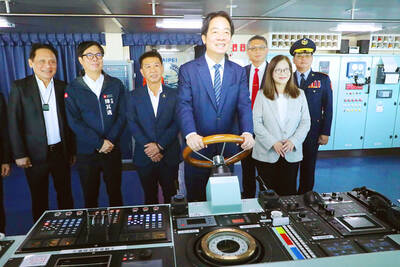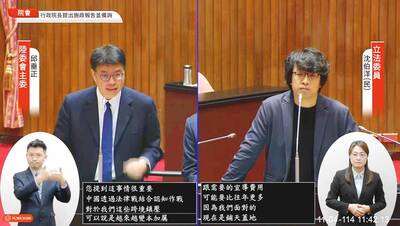Japanese and South Korean military aircraft flew through disputed airspace over the East China Sea without informing China, officials said yesterday, challenging a new Chinese air zone that has increased regional tensions and sparked concerns of an unintended clash.
The move came after Tokyo’s close ally Washington defied China’s demand that airplanes flying through its unilaterally announced zone identify themselves to Chinese authorities, flying two unarmed B-52s over the islands on Tuesday without informing Beijing.
Tensions have ratcheted up since Beijing’s announcement on Saturday of the air defense identification zone (ADIZ) that includes the skies over islands at the heart of a feud between Japan and China, and its demand that planes flying in the area notify Chinese authorities.
Japan and the US have sharply criticized the move, which some experts said was aimed not only at chipping away at Tokyo’s control of the islands, known as the Senkaku in Japan and Diaoyu (釣魚) in China, but also at challenging US dominance in the region. Taiwan also claims the islands, which it calls the Diaoyutais (釣魚台).
The US does not take a position on the sovereignty of the islands, but recognizes Tokyo’s administrative control and has assured Japan that a bilateral security agreement covers them.
The developments are expected to dominate US Vice President Joe Biden’s visit to Japan, China and South Korea next week.
China yesterday also rejected South Korea’s demand for the repeal of the zone, but appeared to soften its demand that commercial aircraft tell its military authorities of any plans to transit the area. Japan’s two biggest airlines have already begun defying that order.
“The East China Sea air defense identification zone is not aimed at normal international flights. We hope that relevant countries’ airlines can proactively cooperate, so there is more order and safety for flights,” Chinese Ministry of Foreign Affairs spokesman Qin Gang (秦剛) told reporters.
Japanese Chief Cabinet Secretary Yoshihide Suga said naval ships and patrol planes have been operating in the East China Sea and would continue to do so.
“They are carrying out surveillance activity as before in the East China Sea, including the zone,” Suga told a news conference, adding there has been no particular response from China. “We are not going to change this [activity] out of consideration to China.”
A South Korean official also said a navy reconnaissance plane had flown over a submerged rock in the area claimed by both Beijing and Seoul, and that the flights would continue.
The rock, called Ieodo in South Korea and the Suyan Rock (苏岩礁) in China, is controlled by Seoul.
Asked about the South Korean flight, Qin only said that Beijing was aware of it.
South Korea’s reaction to Beijing’s weekend declaration had been somewhat muted, reflecting its efforts to forge closer ties with China and a chill in relations with Japan.
However, South Korean Vice Defense Minister Baek Seung-joo yesterday told a senior Chinese military official that the move to impose the new rules created military tension in the region and called on Beijing to rectify the zone
“The Chinese reaction was that they will not be accepting the [South] Korean side’s demand,” South Korean defense ministry spokesman Kim Min-seok told reporters after talks between Baek and Wang Guanzhong (王冠中), deputy chief of general staff of the Chinese People’s Liberation Army.
The Philippines also rejected China’s newly declared air defense zone in the East China Sea as infringing on the freedom to fly in international airspace and compromising the safety of civil aviation.
Philippine foreign affairs spokesman Raul Hernandez said China’s ADIZ threatens the national security of affected states and “transforms the entire air zone” into China’s “domestic airspace.”

CALL FOR SUPPORT: President William Lai called on lawmakers across party lines to ensure the livelihood of Taiwanese and that national security is protected President William Lai (賴清德) yesterday called for bipartisan support for Taiwan’s investment in self-defense capabilities at the christening and launch of two coast guard vessels at CSBC Corp, Taiwan’s (台灣國際造船) shipyard in Kaohsiung. The Taipei (台北) is the fourth and final ship of the Chiayi-class offshore patrol vessels, and the Siraya (西拉雅) is the Coast Guard Administration’s (CGA) first-ever ocean patrol vessel, the government said. The Taipei is the fourth and final ship of the Chiayi-class offshore patrol vessels with a displacement of about 4,000 tonnes, Lai said. This ship class was ordered as a result of former president Tsai Ing-wen’s (蔡英文) 2018

‘SECRETS’: While saying China would not attack during his presidency, Donald Trump declined to say how Washington would respond if Beijing were to take military action US President Donald Trump said that China would not take military action against Taiwan while he is president, as the Chinese leaders “know the consequences.” Trump made the statement during an interview on CBS’ 60 Minutes program that aired on Sunday, a few days after his meeting with Chinese President Xi Jinping (習近平) in South Korea. “He [Xi] has openly said, and his people have openly said at meetings, ‘we would never do anything while President Trump is president,’ because they know the consequences,” Trump said in the interview. However, he repeatedly declined to say exactly how Washington would respond in

WARFARE: All sectors of society should recognize, unite, and collectively resist and condemn Beijing’s cross-border suppression, MAC Minister Chiu Chui-cheng said The number of Taiwanese detained because of legal affairs by Chinese authorities has tripled this year, as Beijing intensified its intimidation and division of Taiwanese by combining lawfare and cognitive warfare, the Mainland Affairs Council (MAC) said yesterday. MAC Minister Chiu Chui-cheng (邱垂正) made the statement in response to questions by Democratic Progressive Party (DPP) Legislator Puma Shen (沈柏洋) about the government’s response to counter Chinese public opinion warfare, lawfare and psychological warfare. Shen said he is also being investigated by China for promoting “Taiwanese independence.” He was referring to a report published on Tuesday last week by China’s state-run Xinhua news agency,

‘ADDITIONAL CONDITION’: Taiwan will work with like-minded countries to protect its right to participate in next year’s meeting, the foreign ministry said The US will “continue to press China for security arrangements and protocols that safeguard all participants when attending APEC meetings in China,” a US Department of State spokesperson said yesterday, after Beijing suggested that members must adhere to its “one China principle” to participate. “The United States insists on the full and equal participation of all APEC member economies — including Taiwan — consistent with APEC’s guidelines, rules and established practice, as affirmed by China in its offer to host in 2026,” the unnamed spokesperson said in response to media queries about China putting a “one China” principle condition on Taiwan’s